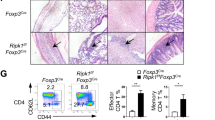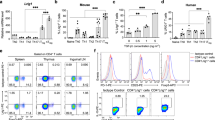Abstract
Regulatory T (Treg) cells play a central role in regulating peripheral immune tolerance and preventing autoimmunity. Despite the extensive studies on the development of Treg cells, the molecular mechanisms that maintain the population of committed Treg cells remain poorly understood. We show here that Treg-conditional ablation of the kinase TAK1 reduced the number of Treg cells in the peripheral lymphoid organs, causing abnormal activation of conventional T cells and autoimmune symptoms. Using an inducible gene knockout approach, we further demonstrate that TAK1 is crucial for the survival of Treg cells. Expression of a constitutively active IκB kinase partially restored the level of Treg cells in the TAK1Treg-KO mice. These results suggest a crucial role for TAK1 for maintaining the survival of committed Treg cells under physiological conditions.
This is a preview of subscription content, access via your institution
Access options
Subscribe to this journal
Receive 12 digital issues and online access to articles
$119.00 per year
only $9.92 per issue
Buy this article
- Purchase on Springer Link
- Instant access to full article PDF
Prices may be subject to local taxes which are calculated during checkout





Similar content being viewed by others
References
Sakaguchi S, Yamaguchi T, Nomura T, Ono M . Regulatory T cells and immune tolerance. Cell 2008; 133: 775–787.
Rudensky AY . Regulatory T cells and Foxp3. Immunol Rev 2011; 241: 260–268.
Shevach EM . Mechanisms of foxp3+ T regulatory cell-mediated suppression. Immunity 2009; 30: 636–645.
von Boehmer H . Mechanisms of suppression by suppressor T cells. Nat Immunol 2005; 6: 338–344.
Cebula A, Seweryn M, Rempala GA, Pabla SS, McIndoe RA, Denning TL, et al. Thymus-derived regulatory T cells contribute to tolerance to commensal microbiota. Nature 2013; 497: 258–262.
Wahl SM, Chen W . Transforming growth factor-beta-induced regulatory T cells referee inflammatory and autoimmune diseases. Arthritis Res Ther 2005; 7: 62–68.
Josefowicz SZ, Lu LF, Rudensky AY . Regulatory T cells: mechanisms of differentiation and function. Annu Rev Immunol 2012; 30: 531–564.
Oh H, Ghosh S . NF-kappaB: roles and regulation in different CD4(+) T-cell subsets. Immunol Rev 2013; 252: 41–51.
Sun SC, Chang JH, Jin J . Regulation of nuclear factor-kappaB in autoimmunity. Trends Immunol 2013; 34: 282–289.
Blonska M, Lin X . CARMA1-mediated NF-kappaB and JNK activation in lymphocytes. Immunol Rev 2009; 228: 199–211.
Thome M, Charton JE, Pelzer C, Hailfinger S . Antigen receptor signaling to NF-kappaB via CARMA1, BCL10, and MALT1. Cold Spring Harb Perspect Biol 2010; 2: a003004.
Liu S, Chen ZJ . Expanding role of ubiquitination in NF-κB signaling. Cell Res 2011; 21: 6–21.
Schmidt-Supprian M, Tian J, Grant EP, Pasparakis M, Maehr R, Ovaa H, et al. Differential dependence of CD4+CD25+ regulatory and natural killer-like T cells on signals leading to NF-kappaB activation. Proc Natl Acad Sci USA 2004; 101: 4566–4571.
Sato S, Sanjo H, Tsujimura T, Ninomiya-Tsuji J, Yamamoto M, Kawai T, et al. TAK1 is indispensable for development of T cells and prevention of colitis by the generation of regulatory T cells. Int Immunol 2006; 18: 1405–1411.
Gupta S, Manicassamy S, Vasu C, Kumar A, Shang W, Sun Z . Differential requirement of PKC-theta in the development and function of natural regulatory T cells. Mol Immunol 2008; 46: 213–224.
Barnes MJ, Krebs P, Harris N, Eidenschenk C, Gonzalez-Quintial R, Arnold CN, et al. Commitment to the regulatory T cell lineage requires CARMA1 in the thymus but not in the periphery. PLoS Biol 2009; 7: e51.
Medoff BD, Sandall BP, Landry A, Nagahama K, Mizoguchi A, Luster AD, et al. Differential requirement for CARMA1 in agonist-selected T-cell development. Eur J Immunol 2009; 39: 78–84.
Molinero LL, Yang J, Gajewski T, Abraham C, Farrar MA, Alegre ML . CARMA1 controls an early checkpoint in the thymic development of FoxP3+ regulatory T cells. J Immunol 2009; 182: 6736–6743.
Isomura I, Palmer S, Grumont RJ, Bunting K, Hoyne G, Wilkinson N, et al. c-Rel is required for the development of thymic Foxp3+ CD4 regulatory T cells. J Exp Med 2009; 206: 3001–3014.
Long M, Park SG, Strickland I, Hayden MS, Ghosh S . Nuclear factor-kappaB modulates regulatory T cell development by directly regulating expression of Foxp3 transcription factor. Immunity 2009; 31: 921–931.
Ruan Q, Kameswaran V, Tone Y, Li L, Liou HC, Greene MI, et al. Development of Foxp3(+) regulatory t cells is driven by the c-Rel enhanceosome. Immunity 2009; 31: 932–940.
Chang JH, Xiao Y, Hu H, Jin J, Yu J, Zhou X, et al. Ubc13 maintains the suppressive function of regulatory T cells and prevents their conversion into effector-like T cells. Nat Immunol 2012; 13: 481–490.
Mihaly SR, Ninomiya-Tsuji J, Morioka S . TAK1 control of cell death. Cell Death Differ 2014; 21: 1667–1676.
Sato S, Sanjo H, Takeda K, Ninomiya-Tsuji J, Yamamoto M, Kawai T, et al. Essential function for the kinase TAK1 in innate and adaptive immune responses. Nat Immunol 2005; 6: 1087–1095.
Shim JH, Xiao C, Paschal AE, Bailey ST, Rao P, Hayden MS, et al. TAK1, but not TAB1 or TAB2, plays an essential role in multiple signaling pathways in vivo. Genes Dev 2005; 19: 2668–2681.
Sakurai H . Targeting of TAK1 in inflammatory disorders and cancer. Trends Pharmacol Sci 2012; 33: 522–530.
Wan YY, Chi H, Xie M, Schneider MD, Flavell RA . The kinase TAK1 integrates antigen and cytokine receptor signaling for T cell development, survival and function. Nat Immunol 2006; 7: 851–858.
Liu HH, Xie M, Schneider MD, Chen ZJ . Essential role of TAK1 in thymocyte development and activation. Proc Natl Acad Sci USA 2006; 103: 11677–11682.
Srinivas S, Watanabe T, Lin CS, William CM, Tanabe Y, Jessell TM, et al. Cre reporter strains produced by targeted insertion of EYFP and ECFP into the ROSA26 locus. BMC Dev Biol 2001; 1: 4.
Chang JH, Hu H, Jin J, Puebla-Osorio N, Xiao Y, Gilbert BE, et al. TRAF3 regulates the effector function of regulatory T cells and humoral immune responses. J Exp Med 2014; 211: 137–151.
Fisson S, Darrasse-Jeze G, Litvinova E, Septier F, Klatzmann D, Liblau R, et al. Continuous activation of autoreactive CD4+ CD25+ regulatory T cells in the steady state. J Exp Med 2003; 198: 737–746.
Huehn J, Siegmund K, Lehmann JC, Siewert C, Haubold U, Feuerer M, et al. Developmental stage, phenotype, and migration distinguish naive- and effector/memory-like CD4+ regulatory T cells. J Exp Med 2004; 199: 303–313.
Hirata Y, Sugie A, Matsuda A, Matsuda S, Koyasu S . TAK1-JNK axis mediates survival signal through Mcl1 stabilization in activated T cells. J Immunol 2013; 190: 4621–4626.
Fukushima T, Matsuzawa S, Kress CL, Bruey JM, Krajewska M, Lefebvre S, et al. Ubiquitin-conjugating enzyme Ubc13 is a critical component of TNF receptor-associated factor (TRAF)-mediated inflammatory responses. Proc Natl Acad Sci USA 2007; 104: 6371–6376.
Yamamoto M, Okamoto T, Takeda K, Sato S, Sanjo H, Uematsu S, et al. Key function for the Ubc13 E2 ubiquitin-conjugating enzyme in immune receptor signaling. Nat Immunol 2006; 7: 962–970.
Yamamoto M, Sato S, Saitoh T, Sakurai H, Uematsu S, Kawai T, et al. Cutting Edge: Pivotal function of Ubc13 in thymocyte TCR signaling. J Immunol 2006; 177: 7520–7524.
Acknowledgements
We thank S Akira for TAK1-flox mice. We also thank the personnel from the NIH/NCI-supported resources (flow cytometry, DNA analysis, histology, and animal facilities) under award number P30CA016672 at the MD Anderson Cancer Center. This work was supported by the 2013 Yeungnam University Research Grant, and the National Research Foundation of Korea Grant funded by the Korean Government (NRF-2014S1A2A2027903) to Jae-Hoon Chang and National Institutes of Health grants (AI057555, AI064639, GM84459, and AI104519) to Shao-Cong Sun.
Author information
Authors and Affiliations
Corresponding author
Rights and permissions
About this article
Cite this article
Chang, JH., Hu, H. & Sun, SC. Survival and maintenance of regulatory T cells require the kinase TAK1. Cell Mol Immunol 12, 572–579 (2015). https://doi.org/10.1038/cmi.2015.27
Received:
Revised:
Accepted:
Published:
Issue Date:
DOI: https://doi.org/10.1038/cmi.2015.27
Keywords
This article is cited by
-
TAK1 is essential for MAIT cell development and the differentiation of MAIT1 and MAIT17
Cellular & Molecular Immunology (2023)
-
Regulatory T cells in tumor microenvironment: new mechanisms, potential therapeutic strategies and future prospects
Molecular Cancer (2020)
-
TBK1 as a regulator of autoimmunity and antitumor immunity
Cellular & Molecular Immunology (2018)



